+Search query
-Structure paper
| Title | Structures of TGF-β with betaglycan and signaling receptors reveal mechanisms of complex assembly and signaling. |
|---|---|
| Journal, issue, pages | Nat Commun, Vol. 16, Issue 1, Page 1778, Year 2025 |
| Publish date | Feb 26, 2025 |
 Authors Authors | Łukasz Wieteska / Alexander B Taylor / Emma Punch / Jonathan A Coleman / Isabella O Conway / Yeu-Farn Lin / Chang-Hyeock Byeon / Cynthia S Hinck / Troy Krzysiak / Rieko Ishima / Fernando López-Casillas / Peter Cherepanov / Daniel J Bernard / Caroline S Hill / Andrew P Hinck /     |
| PubMed Abstract | Betaglycan (BG) is a transmembrane co-receptor of the transforming growth factor-β (TGF-β) family of signaling ligands. It is essential for embryonic development, tissue homeostasis and fertility ...Betaglycan (BG) is a transmembrane co-receptor of the transforming growth factor-β (TGF-β) family of signaling ligands. It is essential for embryonic development, tissue homeostasis and fertility in adults. It functions by enabling binding of the three TGF-β isoforms to their signaling receptors and is additionally required for inhibin A (InhA) activity. Despite its requirement for the functions of TGF-βs and InhA in vivo, structural information explaining BG ligand selectivity and its mechanism of action is lacking. Here, we determine the structure of TGF-β bound both to BG and the signaling receptors, TGFBR1 and TGFBR2. We identify key regions responsible for ligand engagement, which has revealed binding interfaces that differ from those described for the closely related co-receptor of the TGF-β family, endoglin, thus demonstrating remarkable evolutionary adaptation to enable ligand selectivity. Finally, we provide a structural explanation for the hand-off mechanism underlying TGF-β signal potentiation. |
 External links External links |  Nat Commun / Nat Commun /  PubMed:40011426 / PubMed:40011426 /  PubMed Central PubMed Central |
| Methods | EM (single particle) / X-ray diffraction |
| Resolution | 3 - 6.39 Å |
| Structure data | 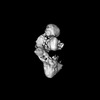 EMDB-50326: Betaglycan in complex with TGF-b1 EMDB-50333, PDB-9fdy: EMDB-50519, PDB-9fk5: EMDB-50524, PDB-9fkp: 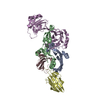 PDB-9b9f: |
| Source |
|
 Keywords Keywords | MEMBRANE PROTEIN / Complex / Betaglycan / TGFBR3 / TGFb / TGFBR1 / TGFBR2 / TGFb1 |
 Movie
Movie Controller
Controller Structure viewers
Structure viewers About Yorodumi Papers
About Yorodumi Papers





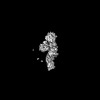
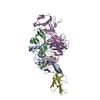

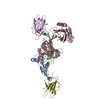

 homo sapiens (human)
homo sapiens (human)
